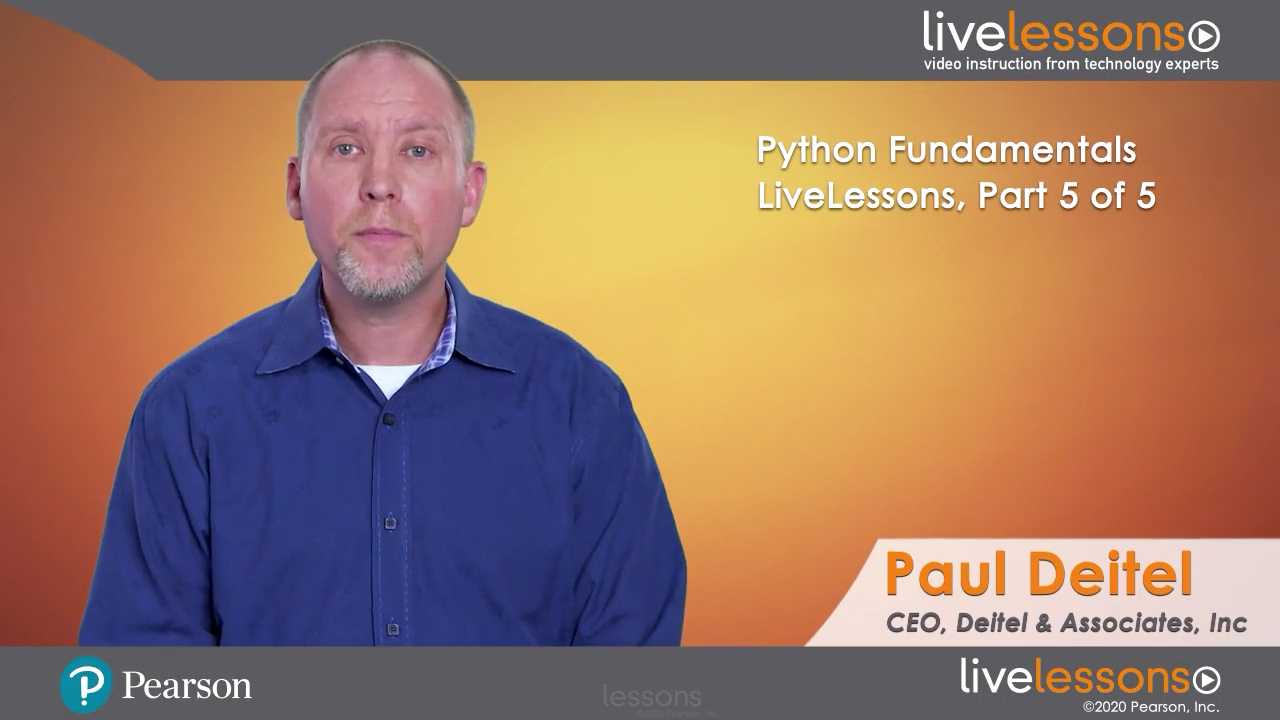Python Fundamentals LiveLessons, Part V (Video Training) : Machine Learning with Classification, Regression & Clustering; Deep Learning with Convolutional & Recurrent Neural Networks; Big Data with Hadoop®, Spark, NoSQL & IoT
- By Paul Deitel
- Published Aug 26, 2019 by Pearson.

Online Video
- Your Price: $199.20
- List Price: $249.00
- About this video
Video accessible from your Account page after purchase.
Register your product to gain access to bonus material or receive a coupon.
Description
- Copyright 2020
- Edition: 1st
- Online Video
- ISBN-10: 0-13-594665-4
- ISBN-13: 978-0-13-594665-7
Approximately 13 hours of video instruction
Overview
The professional programmer’s Deitel® video guide to Python development with the powerful IPython and Jupyter Notebooks platforms. Part V focuses on machine-learning, deep learning and big-data case studies, using popular AI and big-data tools in Python.
Description
Python Fundamentals LiveLessons with Paul Deitel is a code-oriented presentation of Python—one of the world’s most popular and fastest growing languages. In the context of scores of real-world code examples ranging from individual snippets to complete scripts, Paul will demonstrate coding with the interactive IPython interpreter and Jupyter Notebooks. You'll quickly become familiar with the Python language, its popular programming idioms, key Python Standard Library modules and several popular open-source libraries. In the Intro to Data Science videos, Paul lays the groundwork for later lessons in which he’ll introduce some of today's most compelling, leading-edge computing technologies, including natural language processing, data mining Twitter® for sentiment analysis, cognitive computing with IBM® Watson™, supervised machine learning with classification and regression, unsupervised machine learning with clustering, computer vision through deep learning and convolutional neural networks, sentiment analysis through deep learning with recurrent neural networks, big data with Hadoop®, Spark™ streaming, NoSQL databases and the Internet of Things.
NOTE this LiveLesson is one in a series of five:
- Python Fundamentals LiveLessons Part I
- Python Fundamentals LiveLessons Part II
- Python Fundamentals LiveLessons Part III
- Python Fundamentals LiveLessons Part IV
- Python Fundamentals LiveLessons Part V
Skill Level
Beginner-to-Intermediate
What you will learn in Part V’s case studies:
- Lesson 14–Machine Learning: Classification, Regression and Clustering–Use scikit-learn
with popular datasets to perform machine learning studies; Use Seaborn and Matplotlib to visualize and explore data; Perform supervised machine learning with k-nearest neighbors classification and linear regression; Perform multi-classification with Digits dataset; Divide a dataset into training, testing and val idation sets ; Tune hyperparameters with k-fold cross-validation; Measure model performance; Display a confusion matrix showing classification prediction hits and misses; Perform multiple linear regression with the California Housing dataset; Perform dimensionality reduction with PCA and t-SNEon the Iris and Digits datasets to prepare them for two-dimensional visualizations. Perform unsupervised machine learning with k-means clustering and the Iris dataset. - Lesson 15–Deep Learning–What a neural network is and how it enables deep learning; Create Keras neural networks;Keras layers, activat
ion functions , loss functions and optimizers; Use a Keras convolutional neural network (CNN) trained on the MNIST dataset to build a computer vision application that recognizes handwritten digits; Use a Keras recurrent neural network (RNN) trained on the IMDb dataset to create a sentiment analysis application that performs binary classification of positive and negative movie reviews. - Lesson 16–Big Data: Hadoop, Spark, 17–Manipulate a SQLite relational database using SQL; Understand the four major types of NoSQL databases; Store tweets in a MongoDB NoSQL JSON document database and visualize them on a Folium map; Apache Hadoop and how it’s used in big-data batch-processing applications; Build a Hadoop MapReduce application on Microsoft’s Azure HDInsight cloud service; Apache Spark and how it’s used in high-performance, real-time big-data applications; Process mini-batches of data with Spark streaming; Internet of Things (IoT) and the publish/subscribe model; Publish messages from a simulated Internet-connected device and visualize messages in a dashboard; Subscribe to PubNub’s sample live streams and visualize the data.